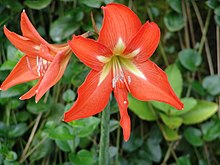
Hippeastrum

Hippeastrum (/ˌhɪpiːˈæstrəm/) is a genus of about 90 species and over 600 hybrids and cultivars of perennial herbaceous bulbous plants. They generally have large fleshy bulbs and tall broad leaves, generally evergreen, and large red or purple flowers. Hippeastrum is a genus in the family Amaryllidaceae (subfamily Amaryllidoideae, tribe Hippeastreae, and subtribe Hippeastrineae). The name Hippeastrum, given to it by William Herbert, means 'Knight's Star', although precisely what Herbert meant by the name is not certain. For many years there was confusion among botanists over the generic names Amaryllis and Hippeastrum, one result of which is that the common name amaryllis is mainly used for cultivars of this genus, often sold as indoor flowering bulbs particularly at Christmas in the northern hemisphere. By contrast the generic name Amaryllis applies to bulbs from South Africa, usually grown outdoors. The genus is native to tropical and subtropical regions of the Americas from Argentina north to Mexico and the Caribbean. Reproduction is generally by allogamy (cross-pollination) and Hippeastrum may be propagated by seed or offset bulbils (bulblets), although commercial ventures use in vitro techniques, or splitting of the bulb into sections. The genus has been intensely bred and cultivated since the early nineteenth century to produce large colourful showy flowers. In temperate climes these can be placed outside in the summer, and after a dormancy period, be induced to rebloom inside in the winter. Most Hippeastrum bulbs are tunicate (a protective dry outer layer and fleshy concentric inner scales or leaf bases). The bulbs are generally between 5–12 cm (2'–5') in diameter and produce two to seven long-lasting evergreen or deciduous leaves that are 30–90 cm (12'–36') long and 2.5–5 cm (1'–2') wide. The leaves are hysteranthous (develop after flowering), sessile, rarely persistent and subpetiolate. The flowers are arranged in umbelliform inflorescences which are pauciflor or pluriflor (2-14 flowers), supported on an erect hollow scape (flower stem) which is 20–75 cm (12'–30') tall and 2.5–5 cm (1'–2') in diameter with two free bracts forming a spathe which is bivalve with free leaflets at its base.Depending on the species, there are two to fifteen large showy flowers, which are more or less zygomophic and hermaphrodite. Each flower is 13–20 cm (5'–8') across, and the native species are usually purple or red. They are funnelform (funnel shaped) and declinate (curving downwards and then upwards at the tip) in shape. The perianth has six brightly colored tepals (three outer sepals and three inner petals) that may be similar in appearance or very different. The perianth segments are subequal or unequal. The tepals are united at the base to form a short tube, usually with a rudimentary scaly paraperigonium with fimbriae or a callose ridge present at the throat. The androecium consists of six stamens with filiform (thread like) filaments, which are fasciculate (in close bundles) and declinate or ascendent. The anthers are dorsifixed or versatile. In the gynaecium, the ovary is inferior and trilocular with pluriovulate locules. The style is filiform, and the stigma trifid. The fruit forms a trivalve capsule containing seeds which are dry, flattened, obliquely winged or irregularly discoid, hardly ever turgid, and globose (spherical) or subglobose, with a brown or black phytomelanous testa. The name Hippeastrum was first given to the genus by Herbert, being derived from the Ancient Greek, meaning a 'Knight's Star' from ἱππεύς (hippeus, mounted knight) and ἄστρον (astron, star), to describe the first recognized species, Hippeastrum reginae. Herbert proposed to call the genus, which he distinguished from Linnaeus' Amaryllis, Hippeastrum, or 'Knight's-star-lily'. He states; Herbert's fourteen species included this Hippeastrum equestre. This 'equine' connection refers to Carl Linnaeus the Younger who had named (in an unpublished manuscript) a West Indian species as Amaryllis equestris, because of its similarity to the African genus Amaryllis. This name and attribution was first published by William Aiton in 1789, in his Hortus Kewensis. Which species this was is not known precisely. However, in 1795 William Curtis, described Amaryllis equestris or the Barbados lily in his Botanical Magazine, referring to Aiton:
